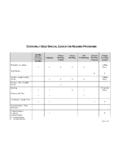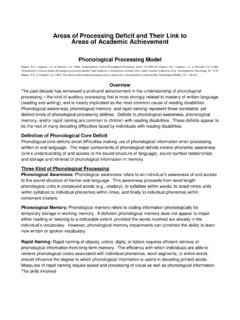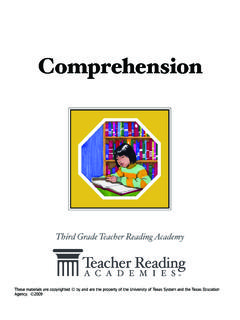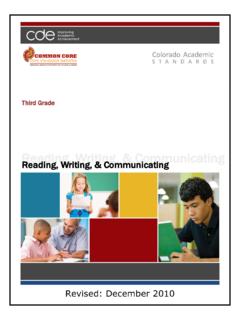Transcription of ELAR TEKS Figure 19 - Positively Affecting The Future
1 ELAR TEKS Figure 19 | 1 ELAR TEKS Figure 19 Figure : 19 TAC (b) ElementaryFigure: 19 TAC (b) Middle SchoolFigure: 19 TAC (b) High SchoolFigure: 19 TAC (b) ESOL I IIStandards for Ensuring Student Success From Kindergarten to College and Career 2009 University of Texas System/Texas Education AgencyComprehension skills in Figure 19 for Grades K 5 Comprehension skills in Figure 19 for Grades 6 8 Comprehension skills in Figure 19 for Courses Eng. I IVComprehension skills in Figure 19 for ESOL I IIELAR TEKS Figure 19 | 2 Comprehension skills in Figure 19 for Grades K 5 Figure : 19 TAC (b) 19 TAC Chapter 110.
2 Texas Essential Knowledge and skills for English Language Arts and reading Subchapter A. Elementary reading /Comprehension skills - Kindergarten ( English Language Arts and reading )First grade ( English Language Arts and reading )Second grade ( English Language Arts and reading )Third grade ( English Language Arts and reading )Fourth grade ( English Language Arts and reading )Fifth grade ( English Language Arts and reading ) reading /Comprehension skills . Students use a flexible range of metacognitive reading skills in both assigned and independent reading to understand an author s message.
3 Students will continue to apply earlier standards with greater depth in increasingly more complex texts as they become self-directed, critical readers. The student is expected to: (A) discuss the purposes for reading and listening to various texts ( , to become involved in real and imagined events, settings, actions, and to enjoy language); (B) ask and respond to questions about text; reading /Comprehension skills . Students use a flexible range of metacognitive reading skills in both assigned and independent reading to understand an author s message. Students will continue to apply earlier standards with greater depth in increasingly more complex texts as they become self-directed, critical readers.
4 The student is expected to: (A) establish purposes for reading selected texts based upon desired outcome to enhance comprehension; (B) ask literal questions of text; reading /Comprehension skills . Students use a flexible range of metacognitive reading skills in both assigned and independent reading to understand an author s message. Students will continue to apply earlier standards with greater depth in increasingly more complex texts as they become self-directed, critical readers. The student is expected to: (A) establish purposes for reading selected texts based upon content to enhance comprehension; (B) ask literal questions of text; reading /Comprehension skills .
5 Students use a flexible range of metacognitive reading skills in both assigned and independent reading to understand an author s message. Students will continue to apply earlier standards with greater depth in increasingly more complex texts as they become self-directed, critical readers. The student is expected to: (A) establish purposes for reading selected texts based upon own or others desired outcome to enhance comprehension; (B) ask literal, interpretive, and evaluative questions of text; reading /Comprehension skills . Students use a flexible range of metacognitive reading skills in both assigned and independent reading to understand an author s message.
6 Students will continue to apply earlier standards with greater depth in increasingly more complex texts as they become self-directed, critical readers. The student is expected to: (A) establish purposes for reading selected texts based upon own or others desired outcome to enhance comprehension; (B) ask literal, interpretive, and evaluative questions of text; reading /Comprehension skills . Students use a flexible range of metacognitive reading skills in both assigned and independent reading to understand an author s message. Students will continue to apply earlier standards with greater depth in increasingly more complex texts as they become self-directed, critical readers.
7 The student is expected to: (A) establish purposes for reading selected texts based upon own or others desired outcome to enhance comprehension; (B) ask literal, interpretive, evaluative, and universal questions of text; ELAR TEKS Figure 19 | 3 Comprehension skills in Figure 19 for Grades K 5 Figure : 19 TAC (b) 19 TAC Chapter 110. Texas Essential Knowledge and skills for English Language Arts and reading Subchapter A. Elementary reading /Comprehension skills - Kindergarten ( English Language Arts and reading )First grade ( English Language Arts and reading )Second grade ( English Language Arts and reading )Third grade ( English Language Arts and reading )Fourth grade ( English Language Arts and reading )Fifth grade ( English Language Arts and reading )(C) monitor and adjust comprehension ( , using background knowledge, creating sensory images, re- reading a portion aloud); (D) make inferences based on the cover, title, illustrations, and plot.
8 (E) retell or act out important events in stories; and (F) make connections to own experiences, to ideas in other texts, and to the larger community and discuss textual evidence. (C) monitor and adjust comprehension ( , using background knowledge, creating sensory images, re- reading a portion aloud); (D) make inferences about text and use textual evidence to support understanding; (E) retell or act out important events in stories in logical order; and(F) make connections to own experiences, to ideas in other texts, and to the larger community and discuss textual evidence. (C) monitor and adjust comprehension ( , using background knowledge, creating sensory images, re- reading a portion aloud, generating questions); (D) make inferences about text using textual evidence to support understanding; (E) retell important events in stories in logical order; and (F) make connections to own experiences, to ideas in other texts, and to the larger community and discuss textual evidence.
9 (C) monitor and adjust comprehension ( , using background knowledge, creating sensory images, re- reading a portion aloud, generating questions); (D) make inferences about text and use textual evidence to support understanding; (E) summarize information in text, maintaining meaning and logical order; and (F) make connections ( , thematic links, author analysis) between literary and informational texts with similar ideas and provide textual evidence. (C) monitor and adjust comprehension ( , using background knowledge, creating sensory images, re- reading a portion aloud, generating questions); (D) make inferences about text and use textual evidence to support understanding; (E) summarize information in text, maintaining meaning and logical order; and (F) make connections ( , thematic links, author analysis) between literary and informational texts with similar ideas and provide textual evidence.
10 (C) monitor and adjust comprehension ( , using background knowledge, creating sensory images, re- reading a portion aloud, generating questions); (D) make inferences about text and use textual evidence to support understanding; (E) summarize and paraphrase texts in ways that maintain meaning and logical order within a text and across texts; and (F) make connections ( , thematic links, author analysis) between and across multiple texts of various genres and provide textual evidence. ELAR TEKS Figure 19 | 4 Comprehension skills in Figure 19 for Grades 6 8 Figure : 19 TAC (b) 19 TAC Chapter 110.

















